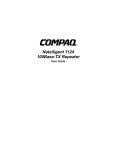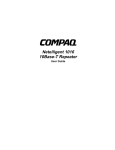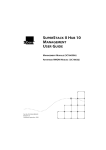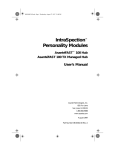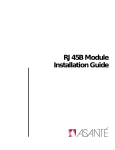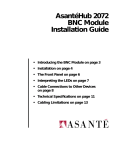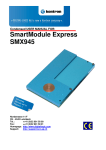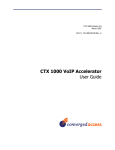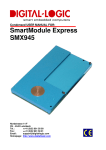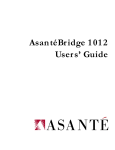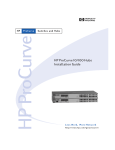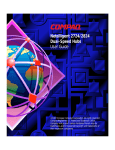Download Compaq Netelligent 1108 User guide
Transcript
Netelligent 1108 100Base-TX Repeater User Guide . . . . . . . . . . . . . . . . . . . . . . . . . . . . . . iii NOTICE The information in this publication is subject to change without notice. COMPAQ COMPUTER CORPORATION SHALL NOT BE LIABLE FOR TECHNICAL OR EDITORIAL ERRORS OR OMISSIONS CONTAINED HEREIN, NOR FOR INCIDENTAL OR CONSEQUENTIAL DAMAGES RESULTING FROM THE FURNISHING, PERFORMANCE, OR USE OF THIS MATERIAL. This publication contains information protected by copyright. No part of this publication may be photocopied or reproduced in any form without prior written consent from Compaq Computer Corporation. The software described in this guide is furnished under a license agreement or non disclosure agreement. The software may be used or copied only in accordance with the terms of the agreement. Product names mentioned herein may be trademarks and/or registered trademarks of their respective companies. 1996 Compaq Computer Corporation. All rights reserved. Printed in the U.S.A. Compaq Registered United States Patent and Trademark Office. Netelligent is a trademark of Compaq Computer Corporation. Compaq Netelligent 1108 100Base-TX Repeater User Guide Second Edition (April 1996) Part Number 185813-002 Writer: Chris Seiter Project: NOTICE Comments: 185813-002/707085-001 File Name:1_NOTICE.DOC Last Saved On:3/28/96 10:19 AM . . . . . . . . . . . . . . . . . . . . . . . . . . . . . v Federal Communications Commission Notice This equipment has been tested and found to comply with the limits for a Class A digital device, pursuant to Part 15 of the FCC Rules. These limits are designed to provide reasonable protection against harmful interference when the equipment is operated in a commercial environment. This equipment generates, uses and can radiate radio frequency energy and, if not installed and used in accordance with the instructions in this manual, may cause interference to radio communications. Operation of this equipment in a residential area is likely to cause harmful interference in which case the user will be required to correct the interference at his own expense. Class A devices bear a label indicating the interference potential of the device as well as additional operating instructions for the user, such as the following: This device complies with Part 15 of the Federal Communications Commission (FCC) Rules. Operation is subject to the following two conditions: (1) This device may not cause harmful interference, and (2) this device must accept any interference received, including interference that may cause undesired operation. Canadian Department of Communications Radio Frequency Statement This digital apparatus does not exceed the Class A limits for radio noise emissions from digital apparatus set out in the Radio Interference Regulations of the Canadian Department of Communications. Le présent appareil numérique n'émet pas de bruits radioélectriques dépassant les limites applicables aux appareils numriques de la classe A prescrites dans le Règlement sur le brouillage radioélectrique édicté par le ministères des Communications du Canada. Modifications The FCC requires the user to be notified that any changes or modifications made to this device that are not expressly approved by Compaq Computer Corporation may void the user’s authority to operate the equipment. Emissions This equipment complies with EMC directive 89/336/EEC (ITE), which includes EN50081-1 CLASS 1: 1992 (EN55022/CISPR 22 for Class A ITE). It also complies with FCC Class A. Writer: Chris Seiter Project: NOTICE Comments: 185813-002/707085-001 File Name:2_NOTICE.DOC Last Saved On:3/13/96 11:23 AM . . . . . . . . . . . . . . . . . . . . . . . . . . . . . vi European Union Notice Products with the CE (Community European) Marking comply with both the EMC Directive (89/336/EEC) and the Low Voltage Directive (73/23/EEC) issued by the Commission of the European Community. Compliance with these directives implies conformity to the following European Norms: ■ EN55022 (CISPR 22) - Electromagnetic Interference ■ EN50082-1 (IEC801-2, IEC801-3, IEC801-4) - Electromagnetic Immunity ■ EN60950 (IEC950) - Product Safety Safety This equipment complies with UL 1950, Second Edition; CAN/CSA C22.2 No. 950-93, 73/23/EEC Low Voltage Directive; TUV Rheinland EN60950, 1988; A1/1990, 1993; and A2/1992, 1992, 1993. Immunity This equipment complies with EMC directive 89/336/EEC (ITE), which includes EN 50082-1: ■ IEC 801-2 (Electrostatic Discharge) ■ IEC 801-3 (Radiated Immunity) ■ IEC 801-4 (Electrical Fast Transient/Burst) ■ EN55101-4 (Conducted Immunity) (not currently required) Netelligent 1108 100Base-T Repeater User Guide Writer: Chris Seiter Project: NOTICE Comments: 185813-002/707085-001 File Name:2_NOTICE.DOC Last Saved On:3/13/96 11:23 AM . . . . . . . . . . . . . . . . . . . . . . . . . . . . . . vii Contents Preface Intended Reader........................................................................................................ix Organization of Contents ..........................................................................................ix Chapter 1 Introduction Features ..................................................................................................................1-1 Hub Components ....................................................................................................1-2 LED Indicators.................................................................................................1-2 RJ-45 Ports.......................................................................................................1-3 Uplink Switch ..................................................................................................1-4 Chapter 2 Planning Hub Installation Before You Begin ...................................................................................................2-1 Installation Requirements........................................................................................2-1 Environmental Requirements ...........................................................................2-1 Electrical Requirements ...................................................................................2-1 Spatial Requirements .......................................................................................2-2 Twisted-Pair (UTP/STP) Wire Requirements ...................................................2-3 System Planning Charts ..........................................................................................2-5 Hub Setup and Cabling Chart...........................................................................2-5 Rack Inventory Chart .......................................................................................2-6 Chapter 3 Installing the Hub Mounting the Hub...................................................................................................3-1 Attaching the Rubber Feet................................................................................3-1 Netelligent 1108 100Base-TX Repeater User Guide Writer: Chris Seiter Project: Introduction Comments: 707085-002/185813-001185813-002/ File Name:MIC100_T.DOC Last Saved On:3/14/96 10:38 AM . . . . . . . . . . . . . . . . . . . . . . . . . . . . . viii Rack-Mounting the Hub...................................................................................3-1 Connecting Twisted-Pair Cable...............................................................................3-2 Setting the Uplink Switch .......................................................................................3-3 Interconnecting Hubs ..............................................................................................3-4 Connecting Power...................................................................................................3-4 Appendix A Specifications Electrical Specifications.........................................................................................A-1 Ports and Connectors.......................................................................................A-1 LED Indicators................................................................................................A-1 Controls ..........................................................................................................A-1 Power Requirements .......................................................................................A-1 Power Consumption ........................................................................................A-1 Power Cord (USA) ..........................................................................................A-1 Physical Specifications ..........................................................................................A-2 Dimensions .....................................................................................................A-2 Weight ............................................................................................................A-2 Environmental Specifications.................................................................................A-2 Operating Environment ...................................................................................A-2 Storage Environment.......................................................................................A-2 Glossary Index Writer: Chris Seiter Project: Introduction Comments: 707085-002/185813-001185813-002/ File Name:MIC100_T.DOC Last Saved On:3/14/96 10:38 AM . . . . . . . . . . . . . . . . . . . . . . . . . . . . . . ix Preface This guide includes information about how to install and operate the 100BaseTX Fast Ethernet repeater. We recommend that you read all chapters in this guide to become familiar with all of the repeater's features and to ensure a successful installation. Intended Reader This guide is written for network administrators and technicians responsible for hardware instalation. Organization of Contents The contents of this guide are organized as follows: Chapter 1 Provides an overview of the 100Base-TX repeater and describes the repeater's features. Chapter 2 Helps you plan the installation of the repeater. Chapter 3 Provides instructions for installing and powering up the repeater and for interconnecting repeaters. Appendix A Includes the repeater's electrical, physical, and environmental specifications. Glossary Provides terms used throughout this guide, as well as general networking terms. Netelligent 1108 100Base-TX Repeater User Guide Writer: Chris Seiter Project: Preface Comments: 185813-002/707085-001 File Name:MIC100_P.DOC Last Saved On:3/13/96 11:17 AM . . . . . . . . . . . . . . . . . . . . . . . . . . . . 1-1 Chapter 1 Introduction The Compaq Netelligent 1108 100Base-TX Repeater (Part No. 267022-001) provides a high-speed solution to increasingly heavy network traffic and slow data throughput. The repeater uses the IEEE 802.3u, 100Base-TX standard to increase the speed of network transmissions by a factor of about 10. This enhanced performance greatly improves your network's efficiency. The repeater has an uplinkable port that lets you connect the repeater to another repeater, providing a maximum of 14 ports on the same collision domain. The repeater also has several LEDs that help you monitor the its status at the repeater and port levels. The repeater provides active management by autopartitioning ports and monitoring error conditions. Features The repeater includes these features: ■ Eight shielded RJ-45 ports to support UTP (Category 5) or STP cable ■ Front-panel uplink switch that lets you connect the repeater to another repeater, providing a maximum of 14 ports on the same collision domain ■ LEDs that indicate power, repeater activity, and collisions for the repeater, and link, activity, and partition status for each port. ■ Transparent active management that autopartitions jabbering ports ■ Full compatibility with the IEEE 802.3u 100Base-TX repeater specification ■ Chassis that can stand alone or be mounted in a standard 19-inch rack ■ Surface-mount technology ■ Built-in power supply that operates on a 100 to 240 VAC, 50 to 60 Hz power source Netelligent 1108 100Base-TX Repeater User Guide Writer: Chris Seiter Project: Introduction Comments: 185813-002/707085-001 File Name:MIC100_1.DOC Last Saved On:3/14/96 10:38 AM . . . . . . . . . . . . . . . . . . . . . . . . . . . . 1-2 Introduction Kit Contents Before you start to install the repeater, verify that this package contains the following items: ■ 1108 100Base-TX Repeater (Part No. 267022-001) ■ Shielded AC power cord ■ Compaq Netelligent 1108 100Base-TX Repeater User Guide Hub Components This section provides an overview of the repeater's components including the LED indicators, RJ-45 ports, and uplink switch. Figure 1-1 shows the repeater front panel and back panel. Power/Segmentation/ Activity LED Indicators RJ-45 Ports and LEDs PWR 1 2 3 4 5 6 7 X X X X X 8 UPLINK ACT COL MDI-X MDI X X UPLINK Switch (for converting Port 8 to uplinkable port) Figure 1-1. Repeater Front Panel Power Cord Connector Figure 1-2. Repeater Back Panel Writer: Chris Seiter Project: Introduction Comments: 185813-002/707085-001 File Name:MIC100_1.DOC Last Saved On:3/14/96 10:38 AM . . . . . . . . . . . . . . . . . . . . . . . . . . . . 1-3 LED Indicators The repeater features several LED indicators that help you monitor the repeater. The LEDs on the left side of the front panel provide the power , activity, and collision status of the repeater. The LEDs above the RJ-45 ports indicate the link, activity, and partition status for each of the ports. Figure 1-2 shows the LED arrangement for the repeater. RJ45 Port LED Indicators PWR 1 2 3 4 5 6 7 8 UPLINK ACT COL MDI-X MDI X X X X X X X Power/Activity/Collision LED Indicators Figure 1-3. LED Indicators The following information lists the possible conditions, colors, and statuses of each LED and describes the meaning of each condition. ■ PWR LED Steady green indicates that power is supplied to the repeater. OFF indicates that no power is supplied to the repeater. ■ ACT LED Flashing green indicates that there is activity at one or more of the repeater's ports. ■ COL LED Flashing yellow indicates that the repeater detects a collision. OFF indicates that no collisions are occurring. ■ RJ-45 LEDs Steady green indicates that a link condition is present. Steady yellow indicates that the port is disabled (autopartitioned). Flashing green indicates that there is activity at the port. Alternately flashing yellow and green indicates that a link condition is present but an error condition, such as a jabber, is being detected. OFF indicates that no link condition is present at the port or there is no connection at the port. NOTE: LEDs listed as yellow might appear orange on the repeater's front panel. Netelligent 1108 100Base-TX Repeater User Guide Writer: Chris Seiter Project: Introduction Comments: 185813-002/707085-001 File Name:MIC100_1.DOC Last Saved On:3/14/96 10:38 AM . . . . . . . . . . . . . . . . . . . . . . . . . . . . 1-4 Introduction RJ-45 Ports The repeater has eight RJ-45 ports that let you connect UTP or STP cabling to workstations and servers in an Ethernet network. Uplink Switch The uplink switch enables the 8th port on the repeater to function as either a standard IN RJ-45 port or an uplinkable OUT” RJ-45 port. IN ports use an internal crossover of the receive and transmit lines, enabling the port to connect to a network interface card using standard 8-wire UTP cable. OUT” ports use a straight-through (uncrossed) connection, enabling the port to connect to any IN port of a second repeater. This allows two repeaters to be on the same segment. UPLINK MDI-X MDI Standard "IN" Repeater Port (Default) 6 7 Uplinkable "OUT" Port 8 UPLINK MDI-X MDI X X Figure 1-4. Uplink Switch Writer: Chris Seiter Project: Introduction Comments: 185813-002/707085-001 File Name:MIC100_1.DOC Last Saved On:3/14/96 10:38 AM . . . . . . . . . . . . . . . . . . . . . . . . . . . . . . 2-1 Chapter 2 Planning Hub Installation This chapter contains information to help you prepare for installing the 100BASE-TX repeater. Installation Requirements To help ensure a correct installation, read this section to determine the environmental, electrical, spatial, and cable requirements. Environmental Requirements Be sure the operating environment for the repeater is within the following ranges: ■ Temperature: 32° to 120° F (0° to 49° C) ■ Humidity: 5% to 95% (non-condensing) ■ Altitude: 0 to 10,000 feet Netelligent 1108 100Base-TX Repeater User Guide Writer: Chris Seiter Project: Planning Hub Installation Comments: 185813-002/707085-001 File Name:MIC100_2.DOC Last Saved On:3/14/96 10:38 AM . . . . . . . . . . . . . . . . . . . . . . . . . . . . . 2-2 Planning Hub Installation Electrical Requirements The electrical requirements for a repeater are as follows: ■ Voltage: 100 to 240 VAC ■ Frequency: 50 to 60 Hz ■ Power: 0.25 to 0.5 Amps maximum CAUTION: The power outlet must be a non-switched, three-pronged, grounded outlet. Do not use a three-to-two pronged adapter at the outlet. Doing so may result in electrical shock and/or damage to the repeater. NOTE: If the supplied shielded power cord is lost or damaged, replace it with an identical shielded power cord set to ensure emissions compliance. Spatial Requirements The repeater's dimensions are 1.75 x 17.00 x 8.5 inches, 4.44 x 43.18 x 21.59 centimeters (HxWxD). You can interconnect two repeaters. If there is not enough space to mount the repeaters in a single rack or stack them on a single shelf, or if you want to place the repeaters in different locations, you can place them on separate shelves or in separate racks. If this is necessary, you will need longer repeater expansion port cables to connect the repeaters. See the “Twisted-Pair (UTP/STP) Wire Requirements” section in this chapter for more information. Be sure to allow at least 2 inches (5.1 centimeters) on each side of the repeater for proper air circulation and cable connections. Twisted-Pair (UTP/STP) Wire Requirements The twisted-pair wiring you use to connect the repeater's RJ-45 ports must meet the following minimum specifications and requirements to ensure longterm LAN reliability. Writer: Chris Seiter Project: Planning Hub Installation Comments: 185813-002/707085-001 File Name:MIC100_2.DOC Last Saved On:3/14/96 10:38 AM . . . . . . . . . . . . . . . . . . . . . . . . . . . . . . 2-3 ■ The wiring must be shielded or unshielded twisted-pair (STP/UTP), Category 5. ■ Two pairs of wiring are required. ■ Depending on building codes, different insulation materials may be required. Plenum-rated or TEFLON-coated wiring may be required in some areas. ■ The wire gauge should be between 18 and 26 AWG. (Most telephone installations use 24-gauge wiring.) ■ UTP wire should meet the following requirements: ❏ Solid copper ❏ Nominal capacitance: less than 16 pF/ft ❏ Nominal impedance: 100 Ohms ❏ Nominal attenuation: less than 11.5 db CAUTION: Never use gray satin station cable for connecting a repeater. This flat cable, typically used for connecting telephones to wall jacks, is incompatible with 100BASE-TX systems. Straight-through twisted-pair cable is typically used to connect a repeater to a server or workstation. In a straight-through connection, Pin 1 at the repeater connects to Pin 1 at the server, Pin 2 at the repeater connects to Pin 2 at the server, and so on. Figure 2-1 shows the locations of pins on a standard RJ-45 plug on a twisted-pair cable. Netelligent 1108 100Base-TX Repeater User Guide Writer: Chris Seiter Project: Planning Hub Installation Comments: 185813-002/707085-001 File Name:MIC100_2.DOC Last Saved On:3/14/96 10:38 AM . . . . . . . . . . . . . . . . . . . . . . . . . . . . . 2-4 Planning Hub Installation Twisted-Pair Cable RJ-45 Plug 1 2 3 6 Pins Figure 2-1. RJ-45 Plug Pin Locations Table 2-1 shows the wiring in a straight-through and crossover twisted-pair cable. (Pins 4, 5, 7, and 8 are not used.) Table 2-1 Straight-Through Twisted-Pair Wiring Twisted Pair Number Pin Number Signal Description To Pin Number Signal Description 1 1 TD+ ➔ 1 TD+ 2 TD- ➔ 2 TD- 3 RD+ ➔ 3 RD+ 6 RD- ➔ 6 RD- 2 Crossover Twisted-Pair Wiring Twisted Pair Number Pin Number Signal Description To Pin Number Signal Description 1 1 TD+ ➔ 3 RD+ 2 TD- ➔ 6 RD- 3 RD+ ➔ 1 TD+ 6 RD- ➔ 2 TD- 2 Writer: Chris Seiter Project: Planning Hub Installation Comments: 185813-002/707085-001 File Name:MIC100_2.DOC Last Saved On:3/14/96 10:38 AM . . . . . . . . . . . . . . . . . . . . . . . . . . . . . . 2-5 System Planning Charts The charts in Figures 2-2 and 2-3 provide a convenient way of planning the connections for your repeater. 100Base-TX Repeater Setup and Cabling Chart Date Unit Number Port Connects To 8 Building Uplink Switch Setting 3 4 Table Mount 5 Rack Mount 6 7 Location 2 MDI-X (default) 1 MDI (uplinkable) Figure 2-2. Hub Setup and Cabling Chart Netelligent 1108 100Base-TX Repeater User Guide Writer: Chris Seiter Project: Planning Hub Installation Comments: 185813-002/707085-001 File Name:MIC100_2.DOC Last Saved On:3/14/96 10:38 AM . . . . . . . . . . . . . . . . . . . . . . . . . . . . . 2-6 Planning Hub Installation Rack Inventory Chart Date Use this chart to record the components installed in a particular rack. Wiring Closet Number Rack Number Installer Example 100Base-TX Repeater 100Base-TX Repeater Figure 2-3. Rack Inventory Chart Writer: Chris Seiter Project: Planning Hub Installation Comments: 185813-002/707085-001 File Name:MIC100_2.DOC Last Saved On:3/14/96 10:38 AM . . . . . . . . . . . . . . . . . . . . . . . . . . . . . . 3-1 Chapter 3 Installing the Repeater This chapter explains how to mount the 100Base-TX repeater, attach cables, and interconnect the repeater to a second 100Base-TX repeater. Mounting the Repeater You can place the repeater on a level surface (table top or shelf, for example) or mount it in a standard EIA 19-inch rack. Attaching the Rubber Feet If you will place the repeater on a table top or shelf, attach the supplied adhesive-backed rubber feet as described in the following steps. 1. Turn the repeater over so that its bottom side faces up. 2. Remove the four rubber feet from their packaging. 3. Peel the protective paper backing off the rubber feet. 4. Then position the feet near the corners of the repeater and press the feet into place. 5. Turn the repeater to its upright position and place it on the mounting surface. NOTE: Be sure you allow at least 2 inches (5.1 centimeters) on each side of the repeater for proper air flow. Rack-Mounting the Repeater To mount the repeater in a rack, you must use the RKIT02 installation kit (not supplied). This kit includes two side mounting brackets and eight screws to secure the brackets. To attach the brackets, position them as shown in Figure 3-1. Then secure the brackets with the screws supplied with the mounting kit. Netelligent 1108 100Base-TX Repeater User Guide Writer: Chris Seiter Project: Installing the Hub Comments: 185813-002/707085-001 File Name:MIC100_3.DOC Last Saved On:3/13/96 11:19 AM . . . . . . . . . . . . . . . . . . . . . . . . . . . . . 3-2 Installing the Hub Figure 3-1. Attaching the Mounting Brackets After you attach both mounting brackets, position the bracket slots over the desired holes on the rack (Figure 3-2). Then insert and tighten the mounting screws (not supplied). PWR 1 2 3 4 5 6 7 X X X X X 8 UPLINK ACT COL MDI-X MDI X X Figure 3-2. Positioning the Repeater in a Rack Connecting Twisted-Pair Cable Each RJ-45 port on the repeater can accept a standard 4-wire twisted-pair (UTP or STP) cable that ends with an RJ-45 connector. These ports can support cable lengths up to 100 meters (328 feet). To attach twisted-pair cable, plug one of the RJ-45 connectors into the selected port on the repeater. Connect the other RJ-45 connector into a 100Base-TX-equipped workstation. Writer: Chris Seiter Project: Installing the Hub Comments: 185813-002/707085-001 File Name:MIC100_3.DOC Last Saved On:3/13/96 11:19 AM . . . . . . . . . . . . . . . . . . . . . . . . . . . . . . 3-3 100Base-TX Repeater PWR 1 2 3 4 5 6 7 8 UPLINK ACT COL MDI-X MDI X X X X X X X 100Base-TX-Equipped Workstation Figure 3-3. Connecting Twisted-Pair Cable Netelligent 1108 100Base-TX Repeater User Guide Writer: Chris Seiter Project: Installing the Hub Comments: 185813-002/707085-001 File Name:MIC100_3.DOC Last Saved On:3/13/96 11:19 AM . . . . . . . . . . . . . . . . . . . . . . . . . . . . . 3-4 Installing the Hub Setting the Uplink Switch The uplink switch lets you convert the repeater's 8th RJ-45 port to an uplinkable port so that you can interconnect two repeaters without the need for special crossover cables. The default setting for the switch is MDI-X (Media Dependent Interface-Reversed that is, standard repeater port). To convert Port 8 to an uplinkable port, use a small, slotted screwdriver, or a similar tool, to set the switch to the MDI position. UPLINK MDI-X MDI Standard "IN" Repeater Port (Default) 6 7 Uplinkable "OUT" Port 8 UPLINK MDI-X MDI X X Figure 3-4. Uplink Switch (Default Setting) Interconnecting Repeaters You can interconnect two repeaters, providing up to 14 ports in the same collision domain (Segment). To interconnect two repeaters, set the uplink switch as described in “Setting the Uplink Switch” in the previous section and connect the repeaters as shown in Figure 3-5. NOTE: The maximum recommended cable distance between two repeaters is 25 meters (82 feet). Exceeding this limit provides unreliable results. Writer: Chris Seiter Project: Installing the Hub Comments: 185813-002/707085-001 File Name:MIC100_3.DOC Last Saved On:3/13/96 11:19 AM . . . . . . . . . . . . . . . . . . . . . . . . . . . . . . 3-5 PWR 1 2 3 4 5 6 7 X X X X X 3 4 5 6 7 8 UPLINK ACT COL MDI-X MDI X PWR 1 X 2 8 UPLINK ACT COL MDI-X MDI X X X X X X X UPLINK MDI-X MDI UPLINK Switch Set to MDI Position Figure 3-5. Interconnecting 100Base-TX Repeaters (Set to MDI Position) Connecting Power Follow these steps to connect the repeater to power: WARNING: The repeater has no power switch. Plugging in the power cord powers up the repeater. 1. Plug the power cord into the power connector on the back of the repeater. 2. Insert the three-pronged plug on the power cord into a non-switched, grounded power outlet on a wall, a power strip, or a grounded extension cord. NOTE: The power outlet should be near the repeater and easily accessible. Netelligent 1108 100Base-TX Repeater User Guide Writer: Chris Seiter Project: Installing the Hub Comments: 185813-002/707085-001 File Name:MIC100_3.DOC Last Saved On:3/13/96 11:19 AM . . . . . . . . . . . . . . . . . . . . . . . . . . . . . 3-6 Installing the Hub Power Cord Connector Figure 3-6. Connecting the Power Cord When you plug in the power cable, the PWR LED lights steady green. Disconnecting Power To power down the repeater, disconnect the power cord from the outlet. Do not power down the repeater by disconnecting the power cord from the repeater. Writer: Chris Seiter Project: Installing the Hub Comments: 185813-002/707085-001 File Name:MIC100_3.DOC Last Saved On:3/13/96 11:19 AM . . . . . . . . . . . . . . . . . . . . . . . . . . . . . . A-1 Appendix A Specifications Electrical Specifications Ports and Connectors ■ Eight RJ-45 ports LED Indicators ■ Power (PWR), Activity (ACT), and Collision (COL) status ■ Eight RJ-45 port to indicate link, activity, and partition status ■ Two-position (MDI/MDI-X) uplink switch Controls Power Requirements ■ Voltage: 100 to 240 VAC ■ Frequency: 60 to 50 Hz ■ Power: 0.25 to 0.5 Amps maximum Power Consumption ■ Maximum: 16.2 W Power Cord (USA) ■ Shielded 1.8 meters (6 feet), 10 Amps Netelligent 1108 100Base-TX Repeater User Guide Writer: Chris Seiter Project: Spec ifications Comments: 185813-002/707085-001 File Name:MIC100_A.DOC Last Saved On:3/13/96 11:19 AM . . . . . . . . . . . . . . . . . . . . . . . . . . . . . A-2 Specifications Physical Specifications Dimensions ■ 1.75 x 17 x 8.5 inches, 4.44 x 43.18 x 21.59 cm (HxWxD) ■ 4 pounds (1.81 kg) Weight Environmental Specifications Operating Environment ■ 32° to 120° F (0° to 49° C) ■ 5% to 95% humidity (non-condensing) Storage Environment ■ 32° to 151° F (0° to 66° C) ■ 5% to 95% humidity (non-condensing) ■ 0 to 30,000 feet altitude (0 to 9 kilometers) Writer: Chris Seiter Project: Specifications Comments: 185813-002/707085-001 File Name:MIC100_A.DOC Last Saved On:3/13/96 11:19 AM . . . . . . . . . . . . . . . . . . . . . . . . . . . . . G-1 Glossary 10Base-T An IEEE standard (802.3) for unshielded twisted-pair (UTP) wiring. Stations are connected using a star topology. The maximum segment length is 100 meters. 100BASE-TX An IEEE standard (802.3u) for high-speed Ethernet. 802.2 An IEEE standard that governs Logical Link Control (LLC). The LLC layer can provide either connections-oriented services, connectionless services, or a combination of both. 802.3 An IEEE standard that governs Carrier Sense Multiple Access/Collision Detect (CSMA/CD) networks. 802.3, referred to as Ethernet, operates on different cable types (for example, UTP, coax, fiber). adapter See NIC. AUI (attachment unit interface) See transceiver cable. backplane The data bus connections used to interconnect different communication modules inside a networking concentrator. Netelligent 1108 100Base-TX Repeater User Guide Writer: Chris Seiter Project: Glossary Comments: 185813-002/707085-001 File Name:MIC100_G.DOC Last Saved On:3/13/96 11:18 AM . . . . . . . . . . . . . . . . . . . . . . . . . . . . . G-2 bridge A program running on a computer connecting two LANs that allows traffic from one network to be exchanged with the other network. The networks can be the same or different (for example, Ethernet and Token Ring). carrier sense The monitoring of a local area network by a node to determine if another node is transmitting. Class 1 LED See LED. coax, coaxial cable A type of shielded cable used in communication networks. Different types of coaxial cable include Ethernet and RG-6. collision Simultaneous transmission on the communication media. concentrator A device that houses other repeaters and modules, to provide connectivity between data terminals in a network. configuration The layout of nodes and components in the network. Writer: Chris Seiter Project: Glossary Comments: 185813-002/707085-001 File Name:MIC100_G.DOC Last Saved On:3/13/96 11:18 AM . . . . . . . . . . . . . . . . . . . . . . . . . . . . . . G-3 cross connect A panel on which the leads of station cable are mounted so that a technician, other wiring craftsperson, or the system administrator can make electrical connections between the communications devices wired to the cables. dielectric A substance that does not conduct electrical current. Electronic Industry Association (EIA) Ethernet II Ethernet II or DIX was defined by Digital, Intel, and Xerox. The frame format for Ethernet II differs from that of 802.3 in that the header specifies a packet type instead of the packet length. Fiber Distributed Data Interface (FDDI) A high-speed networking standard. The underlying medium is fiber optics, and the topology is a dual-attached, counter-rotating token ring. hot-swappable Refers to the ability of a module, switch, or repeater to be added or removed from a stack without removing power from the switch or repeater. jabbering Continuous transmission from a node, generally as a result of a hardware or firmware failure. Netelligent 1108 100Base-TX Repeater User Guide Writer: Chris Seiter Project: Glossary Comments: 185813-002/707085-001 File Name:MIC100_G.DOC Last Saved On:3/13/96 11:18 AM . . . . . . . . . . . . . . . . . . . . . . . . . . . . . G-4 Local Area Network (LAN) A communication system which covers a limited geographical area, as distinguished from a Wide Area Network which spans a wide geographical area. Light Emitting Diode (LED) A device that emits light at a power level well within guidelines for eye safety. LEDs are typically used to indicate the operating status of a repeater or module. Link Test A test that is performed by the hardware to ensure the integrity of the cable. The link test can be disabled to allow old style NICs incapable of performing a link test to connect to the repeater. modular cord A cord containing four twisted pairs of wires, with a modular plug on one or both ends. module The component that provides connectivity ports for the LAN. Modules are installed in larger systems, called concentrators. Network Interface Card (NIC) A card which plugs into a device and allows it to be connected to a network. node A device that is attached to a network and communicates by means of the network. Any network station Writer: Chris Seiter Project: Glossary Comments: 185813-002/707085-001 File Name:MIC100_G.DOC Last Saved On:3/13/96 11:18 AM . . . . . . . . . . . . . . . . . . . . . . . . . . . . . . G-5 partition The electrical disconnecting of a node from a LAN at its point of connection to a repeater. The node remains physically attached. Protocol Data Unit (PDU) A packet that contains control information and optional data. plenum cord Communications cord with fire-retardant insulation, generally used in suspended ceilings and other places where air circulates back to the building's air-conditioning system. Port An external connector used to connect PCs and other node devices to the network. repeater A device that provides connectivity between data terminal equipment. Localizes the connections for multiple network nodes. A repeater is sometimes called a concentrator. RS-232 Recommended standard 232 defines a standard way of transferring serial information by wire using single-ended line drivers and receivers. RS-232 lines generally include transmit, receive, ground, and various control lines. RS-485 Recommended standard 485 defines a standard way of transferring serial information by wire using differential line drivers and receivers. Netelligent 1108 100Base-TX Repeater User Guide Writer: Chris Seiter Project: Glossary Comments: 185813-002/707085-001 File Name:MIC100_G.DOC Last Saved On:3/13/96 11:18 AM . . . . . . . . . . . . . . . . . . . . . . . . . . . . . G-6 RJ-45 A connector used for 10Base-T wiring (unshielded twisted-pair Ethernet). router A device used to connect two or more networks at the Network layer of the ISO-OSI reference model. The router must understand the communication protocols being used because it uses information provided by the protocols in each packet to determine how to route the packets. segmentation Segmentation is the process of dividing a network into multiple collision domains. stack A stack is a group of interconnected repeaters. 10Base-T IEEE 802.3 standard for twisted-pair Ethernet. 10 Mb/s over baseband using unshielded, twisted-pair cable. Telco A 25-pair polarized connector that is used to consolidate multiple voice or data lines. Writer: Chris Seiter Project: Glossary Comments: 185813-002/707085-001 File Name:MIC100_G.DOC Last Saved On:3/13/96 11:18 AM . . . . . . . . . . . . . . . . . . . . . . . . . . . . . . G-7 twisted pair wire Two insulated copper wires twisted together. The twists vary in length to reduce the potential for signal interference between pairs. In cables greater than 25 pairs, the twisted pairs are grouped and bound together in a common cable sheath. Twisted pair cable is the most common of transmission media. Unshielded Twisted Pair (UTP) Cable usually connected using RJ-45 connectors wiring environment Any building communications wiring system. See also 66-type wiring environment. wiring closet A room, closet, or cabinet where station cable is terminated on crossconnect blocks and where the building communications system can be administered. Netelligent 1108 100Base-TX Repeater User Guide Writer: Chris Seiter Project: Glossary Comments: 185813-002/707085-001 File Name:MIC100_G.DOC Last Saved On:3/13/96 11:18 AM . . . . . . . . . . . . . . . . . . . . . . . . . . . . . . I-1 Index I 1 IEEE 802.3u 1-1 IN ports definition 1-4 Installation 3-1 planning 2-1 Interconnecting repeaters 3-4 100Base-TX 1-1, 1-2, 2-1, 2-3, 3-2 A Activity LED 1-3 Air circulation 2-2 Altitude ranges 2-1 B Back panel 1-2 L LEDs 1-1, 1-2 ACT 1-3 COL 1-3 PWR 1-3, 3-6 RJ-45 1-3 M C Cable, crossover 2-4 Chart, rack inventory 2-6 Collision domain 3-4 Collision status LED 1-3 Components 1-2 Crossover 1-4 MDI 3-4 MDI-X 3-4 Mounting 3-1 Mounting brackets, attaching 3-2 N Network interface card 1-4 D O Dimensions 2-2 OUT 1-4 F P Features 1-1 Frequency 2-2 Front panel 1-2 H Humidity ranges 2-1 Planning charts 2-5 Ports RJ-45 1-1 Power 1-3, 2-2 connecting 3-5 cord 2-2, 3-5 disconnecting 3-6 outlet 2-2, 3-5 Netelligent 1108 100Base-TX Repeater User Guide Writer: Chris Seiter Project: Introduction Comments: 185813-002/707085-001 File Name:MIC100_I.DOC Last Saved On:3/13/96 11:17 AM . . . . . . . . . . . . . . . . . . . . . . . . . . . . . . I-2 Index requirements 2-2 Power LED 1-3 W R Wiring crossover 2-4 guage 2-3 straight-through 2-4 Rack-mounting repeater 3-1 Requirements electrical 2-1 environmental 2-1 spatial 2-2 RJ-45 1-1 RJ-45 ports 1-2–1-4, 1-2 RKIT02 3-1 Rubber feet, attaching 3-1 S Segment 1-4, 3-4 STP 1-1, 1-4, 2-3, 3-2 Straight-through (uncrossed) connection 1-4 T Temperature ranges 2-1 Twisted-pair connecting 3-2 specifications 2-3 U Uplink switch 1-4 setting 3-4 UTP 1-1, 1-4, 2-3, 3-2 V Voltage 2-2 Writer: Chris Seiter Project: Introduction Comments: 707085-001/185813-001185813-002/707085-001 File Name:MIC100_I.DOC Last Saved On:3/13/96 11:17 AM


































